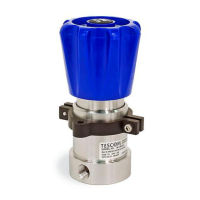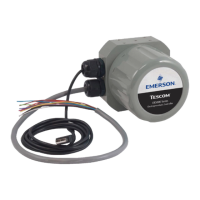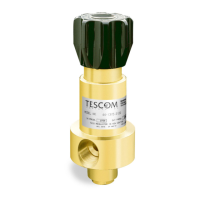7
Section 3
Rev. 06/15
Safety, Installation, Operations & Service Manual
DOPSM2080X012
Piston-Sensed - Pressure Reducing Regulators
By Series
• 20-1000
• 20-1100
• 20-1200
• 26-1000
• 26-2000
• 44-1100
• 44-1300
• 44-1500
• 44-1800
• 44-4000
• 44-4200
• 44-5200
• 44-7400
• 50-2000
• 50-2200
• 50-4000
• 50-4100
• 54-2000
• 54-2200
• 54-2800
• 56-2000
• BB-1
• CP3200
Piston-Sensed - Back Pressure Regulators
By Series
• 26-1700
• 44-1700
• 44-5500
• 44-2900
• 54-2100
• 54-2300
• 54-2700
• 54-3500
• BB-3
3.2 Pressure Reducing Regulators - Diaphragm-
Sensed
3.2.1 General
TESCOM’s diaphragm sensed pressure reducing regulators are specifically engineered for
applications requiring dependable pressure regulation. These regulators are especially
appropriate for installations where high system pressures (up to 6000 psi) must be reduced
to levels suitable for actuating low pressure (28 vac to 500 psi) instruments and related
equipment.
3.2.2 Pressure Activation Methods
TESCOM uses three basic types of activation methods. The activation method provides the
means by which the operator can set the force that determines the outlet pressure of a
regulator.
Control Knob: Delivery pressure is increased by turning the control knob. The control knob
applies a load through a spring to the diaphragm.
Dome Load: Delivery pressure is increased by applying pressurized gas or liquid to the
dome of a regulator at a pressure equal to the outlet pressure desired. This dome pressure
is normally provided by a second regulator called the pilot regulator.
Combination Spring and Dome: Delivery pressure is increased by applying a spring force as
well as the introduction of pressurized gas or liquid.
3.2.3 Operation (Control Knob Adjustment)
Controlled outlet pressure settings are obtained using TESCOM pressure reducing
regulators by adjusting the control knob. Rotating the knob clockwise raises the outlet
pressure while a counterclockwise rotation coupled with venting of the downstream side
of the regulator plumbing lowers the outlet pressure. Final adjustments should be made in
the direction of increasing pressure to obtain the most accurate set point.
TESCOM regulators will operate with any liquid or gaseous media compatible with the
wetted materials. Some series/modifications come with an internal filter designed to

